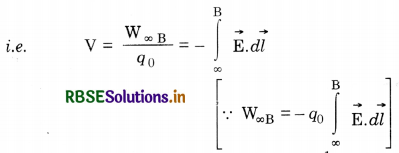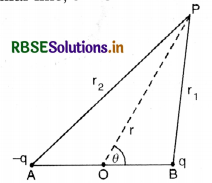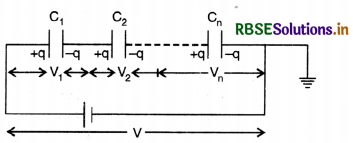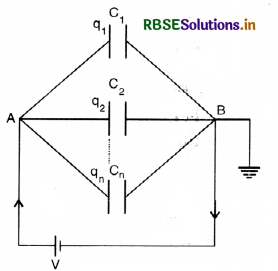RBSE Class 12 Physics Notes Chapter 2 Electrostatic Potential and Capacitance
These comprehensive RBSE Class 12 Physics Notes Chapter 2 Electrostatic Potential and Capacitance will give a brief overview of all the concepts.
Rajasthan Board RBSE Solutions for Class 12 Physics in Hindi Medium & English Medium are part of RBSE Solutions for Class 12. Students can also read RBSE Class 12 Physics Important Questions for exam preparation. Students can also go through RBSE Class 12 Physics Notes to understand and remember the concepts easily. Browsing through wave optics important questions that include all questions presented in the textbook.
RBSE Class 12 Physics Chapter 2 Notes Electrostatic Potential and Capacitance
Electrostatic Potential:
Electric potential is the degree of electrification and it determines the flow of charge from one point to another in an electric field. Electric potential at a point in an electric field is defined as the amount of work done in bringing a unit positive charge from infinity to that point against the electric force.
So, electric potential = \(\frac{\text { Work done }}{\text { Charge }}\)

SI unit of electric potential is volt (or JC-1) and its dimensional formula is [ML2 T-3].
Electrostatic potential difference between two points in an electric field is defined as the amount of work done in moving a unit positive test charge from one point to the other (without acceleration) against the electrostatic force. The potential difference between two points A and B at distances rA and rB from point charge q having potentials VA and VB (VB - VA) is given by
VB - VA = \(\frac{q}{4 \pi \varepsilon_0}\left[\frac{1}{r_{\mathrm{B}}}-\frac{1}{r_{\mathrm{A}}}\right]\)
Electric potential due to electric dipole at any point P is given by
V = \(\frac{p \cos \theta}{4 \pi \varepsilon_0 r^2}\)
On the axial line, θ = 0°

∴ V = \(\frac{p}{4 \pi \varepsilon_0 r^2}\)
On the equatorial line, θ = 90°
∴ V = 0
Characteristics of potential (V)
- Potential is a scalar quantity.
- Its value at infinity is zero.
- Potential is positive if q > 0 and negative if q < 0
- Potential depends only on the distance from the source charge.

Equipotential surfaces
An equipotential surface is that at every point of which electric potential is the same.
Characteristics of equipotential surface
- No work is done in moving a test charge over an equipotential surface
i.e WAB = 0 - Electric field intensity E is perpendicular to the equipotential surface.
- Equipotential surfaces help us to distinguish regions of strong field from those of weak fields.
Electrostatic shielding:
Electrostatic shielding is the phenomenon in which a certain region of space is protected from the
electric field. Since electric field inside a conductor is zero, so to protect delicate instruments from external electric field, we enclose them in hollow' conductor. For example, in electronic devices, certain circuits or components are shielded by covering them with metal shields.
Electric Potential Energy:
Electric potential energy of a system of point charges is the total amount of work done in bringing the various charges to their respective positions from infinitely large mutual separations.
Electric potential energy of a system of two point charges is given by
U = W = \(\frac{1}{4 \pi \varepsilon_0} \frac{q_1 q_2}{r_{12}}\)
Electrical Capacitance:
Capacitance of a conductor
The capacitance of a conductor is the ratio of the charge on the conductor to its potential.
i.e C = \(\frac{q}{V}\)
And the unit of capacitance of capacitor in SI is farad.
And IF = \(\frac{1C}{1V}\) = 1C V-1
Capacitor:
A capacitor is an arrangement for storing large amount of electric charge and hence electrical energy, in a small space.
Capacitance of a capacitor:
Capacitance of a capacitor is defined as the ratio of charge q on the plates of capacitor to the potential difference V across its plate i.e. C = q/V.

Capacitance of a capacitor:
Capacitance of a capacitor is also given by
- Capacitance of a spherical capacitor of radius r is given by C = 4πε0r
- Capacitance of a parallel plate capacitor separated by small distance d is given by
C = \(\frac{\varepsilon_0 \mathrm{~A}}{d}\) (medium between capacitor plates is air or vaccum) - If medium between plates is other than air having dielectric constant K, then
C = \(\frac{\varepsilon_0 \mathrm{KA}}{d}\)
Dielectric:
A dielectric is a material that does not conduct electric current through it. Molecules of a dielectric are of two types.
- Polar molecule is one in which the centre of gravity of positive charges does not coincide with the centre of gravity of negative charge e.g. HCl, NH3, H2O, CO etc.
- Non-polar molecule is one, in which the centre of gravity of positive charges coincide with the centre of gravity of the negative charges e.g. O2, H2, N2, etc.
Effect of dielectric in a capacitor
When a slab of a dielectric is introduced between the plates of a parallel plate capacitor, the capacitance of capacitor becomes
C = \(\frac{\mathrm{K} \varepsilon_0 \mathrm{~A}}{\mathrm{~K}(d-t)+t}\)
If t = d, C = \(\frac{\mathrm{KA} \varepsilon_0}{d}\)
Grouping of Capacitors:
Capacitors can be grouped in series or in parallel as per the requirement.
(i) Capacitors in series. Capacitors are said to be connected in series if the second plate of one capacitor is connected to the first plate of the next and so on as shown in the figure ahead.

Resultant capacitance will be
\(\frac{1}{\mathrm{C}}=\frac{1}{\mathrm{C}_1}+\frac{1}{\mathrm{C}_2}+\ldots \ldots \ldots \ldots \ldots \ldots+\frac{1}{\mathrm{C}_n}\)
(ii) Capacitors in parallel
Capacitors are said to be connected in parallel if the “positively charged plates” of all the capacitors are connected together at a point A, while the ‘earthed’ plates are connected together at another point B as shown in the figure.

Resultant capacitance will be
C = C1 + C2 + .......... + Cn
Energy stored in a capacitor is given by
U= \(\frac{1}{2}\)CV2 = \(\frac{1}{2} \frac{q^2}{\mathrm{C}}=\frac{1}{2}\) qV
Both in series combination and parallel combinations, the total energy stored is equal to sum of the energies stored in individual capacitors.
i.e. U = C1 + C2 + .......... + Cn

Van de Graaff electrostatic:
Van de Graaff electrostatic generator is based on the principle that
- If a charged conductor is in internal contact with another hollow conductor the hollow conductor accept all charge of the conductor irrespective of its own potential
- The electric discharge takes place in air or gases readily at pointed conductors.

- RBSE Class 12 Physics Notes Chapter 2 स्थिर वैद्युत विभव तथा धारिता
- RBSE Class 12 Physics Notes Chapter 3 विद्युत धारा
- RBSE Class 12 Physics Notes Chapter 4 गतिमान आवेश और चुंबकत्व
- RBSE Class 12 Physics Notes Chapter 5 चुंबकत्व एवं द्रव्य
- RBSE Class 12 Physics Notes Chapter 6 वैद्युत चुंबकीय प्रेरण
- RBSE Class 12 Physics Notes Chapter 7 प्रत्यावर्ती धारा
- RBSE Class 12 Physics Notes Chapter 8 वैद्युतचुंबकीय तरंगें
- RBSE Class 12 Physics Notes Chapter 9 किरण प्रकाशिकी एवं प्रकाशिक यंत्र
- RBSE Class 12 Physics Notes Chapter 10 तरंग-प्रकाशिकी
- RBSE Class 12 Physics Notes Chapter 11 विकिरण तथा द्रव्य की द्वैत प्रकृति
- RBSE Class 12 Physics Notes Chapter 12 परमाणु